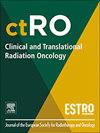Mepitel®膜与标准护理预防辅助放疗乳腺癌患者皮肤毒性:一项随机对照试验
IF 2.7
3区 医学
Q3 ONCOLOGY
引用次数: 0
摘要
背景,目的放射治疗在乳腺癌治疗中起着关键作用,然而,放射性皮炎会影响治疗的效果和患者的生活质量。主要结局是比较Mepitel®Film与标准治疗在预防放射治疗皮肤毒性发作方面的效果。方法一项多中心随机对照III期研究比较了标准治疗(在放疗开始时使用水尿素乳膏-表皮U水洗液和在湿性脱屑开始时使用抗菌乳膏- Flammazine或Ialugen Plus)与Mepitel®Film对乳腺癌术后放疗患者的影响。主要观察指标为实验组和对照组湿性脱屑比例(RTOG评分≥2)。结果在研究期间(2016-2020年),随机抽取161例患者,154例(95.7%)可评估。试验组和对照组皮肤毒性放射治疗肿瘤组(RTOG)评分≥2分的分别为9.5%和13.9%(相对危险度= 0.68,95% CI 0.28-1.66;p = 0.393)。RTOG分数>;实验组和对照组的相对危险度分别为90.5%和94.9%(相对危险度= 0.95,95% CI 0.87-1.04;p = 0.294)。多变量分析,控制年龄,糖尿病,BMI和吸烟暴露,显示RTOG的风险降低;0 = 38% (HR = 0.62 95% CI 0.49-0.96, p = 0.028), RTOG和gt的风险降低;1 / 33 (HR = 0.67 95% CI 0.26-1.76, p = 0.420)。从RTOG等级恢复的中位时间>;实验组和对照组毒性分别为17和32 d (p = 0.027)。在多变量分析中,实验组恢复时间快38% (HR = 1.38, 95% CI (0.99-1.93) p = 0.059)。结论:虽然该研究没有显示RTOG和gt的统计学显著降低;2 .皮肤毒性,有证据表明皮肤毒性发生率降低,恢复时间缩短。患者对该装置的耐受性良好。本文章由计算机程序翻译,如有差异,请以英文原文为准。
Mepitel® film versus standard care for the prevention of skin toxicity in breast cancer patients treated with adjuvant radiotherapy: A randomized controlled trial
Background & purpose
Radiotherapy plays a key role in breast cancer treatment however, radiation-induced dermatitis can impact on treatment delivery and patient quality of life.
The primary outcome was to compare Mepitel® Film versus standard treatment in preventing radiotherapy skin toxicity onset.
Methods
A multicentre randomised controlled phase III study compared standard treatment (aqueous-urea cream − Excipial U hydrolotion applied at the beginning of radiotherapy and antiseptic cream − Flammazine or Ialugen Plus applied at the onset of moist desquamation) versus Mepitel® Film in patients with breast cancer undergoing post-operative radiotherapy. The primary outcome was the proportion of moist desquamation (RTOG score ≥ 2) in the experimental and control groups.
Results
During the study (2016–2020), 161 patients were randomized, 154 (95.7 %) were evaluable. Skin toxicity Radiation Therapy Oncology Group (RTOG) score ≥ 2 was observed in 9.5 % and 13.9 % of experimental and control groups respectively (Relative Risk = 0.68, 95 %CI 0.28–1.66; p = 0.393). RTOG scores > 0 were 90.5 % and 94.9 % in experimental and control groups respectively (Relative Risk = 0.95, 95 %CI 0.87–1.04; p = 0.294).
Multivariable analysis, controlled for age, diabetes, BMI and smoking exposure, showed a risk reduction of RTOG > 0 of 38 % (HR = 0.62 95 %CI 0.49–0.96, p = 0.028), and a risk reduction of RTOG > 1 of 33 % (HR = 0.67 95 %CI 0.26–1.76, p = 0.420) in the experimental group.
The median time to recovery from RTOG grade > 0 toxicity was 17 and 32 days for experimental and control groups, respectively (p = 0.027). At multivariable analysis, time to recovery was 38 % faster in the experimental group (HR = 1.38 95 %CI (0.99–1.93) p = 0.059).
Conclusions
Although the study did not demonstrate a statistically significant reduction in RTOG > 2 skin toxicity, there was evidence of a reduction in the rate of skin toxicity and an improvement in time to recovery. The device was well tolerated by patients.
求助全文
通过发布文献求助,成功后即可免费获取论文全文。
去求助
来源期刊

Clinical and Translational Radiation Oncology
Medicine-Radiology, Nuclear Medicine and Imaging
CiteScore
5.30
自引率
3.20%
发文量
114
审稿时长
40 days
 求助内容:
求助内容: 应助结果提醒方式:
应助结果提醒方式:


